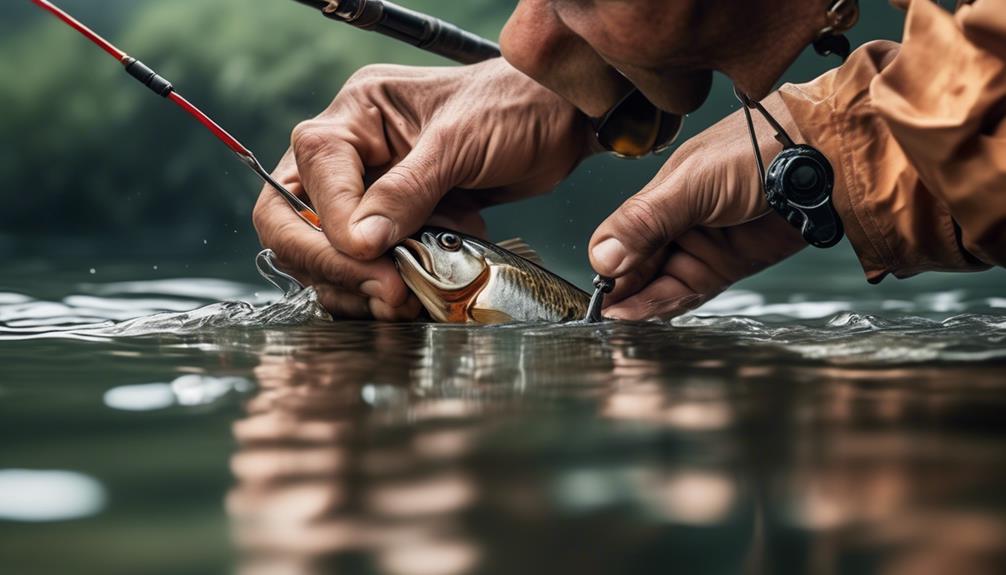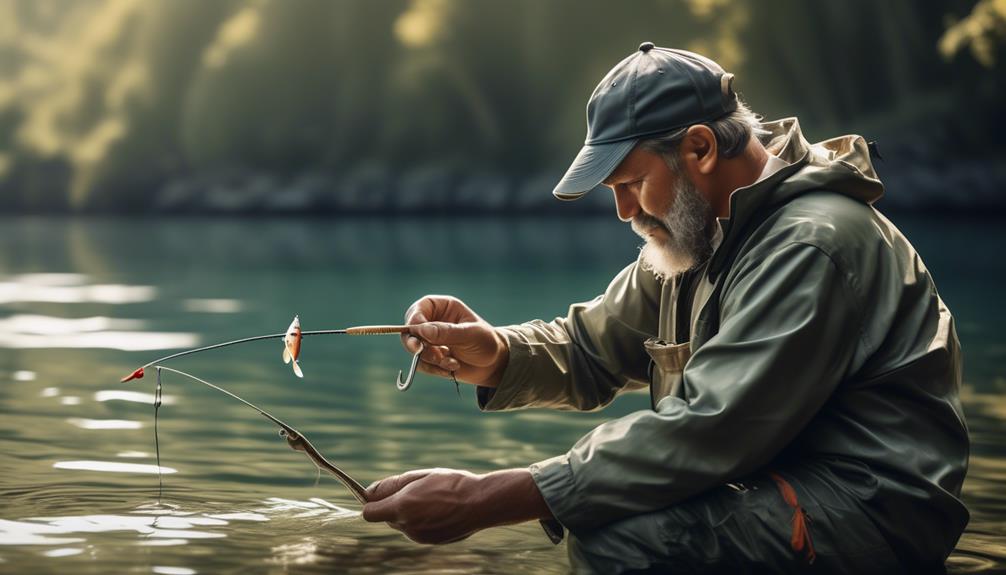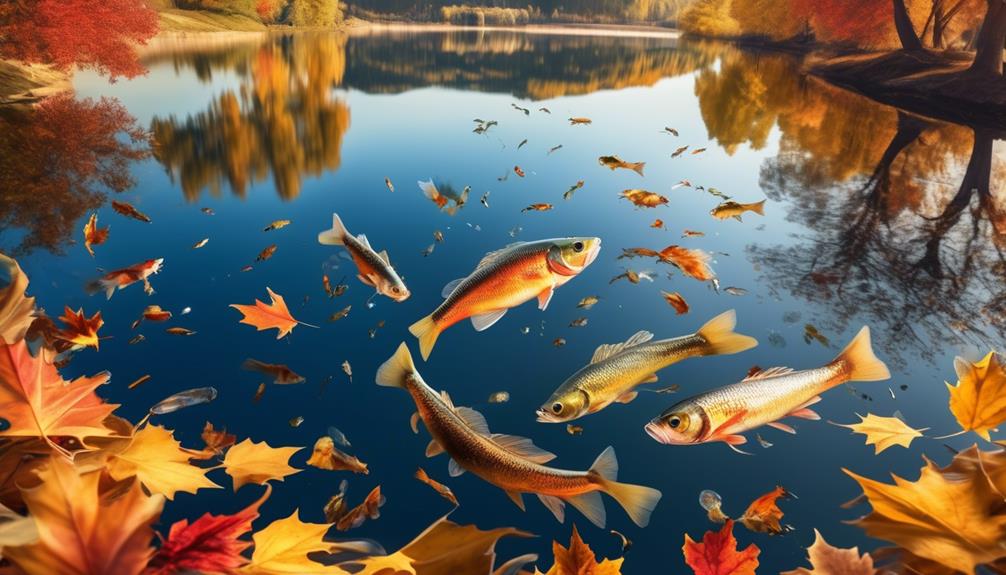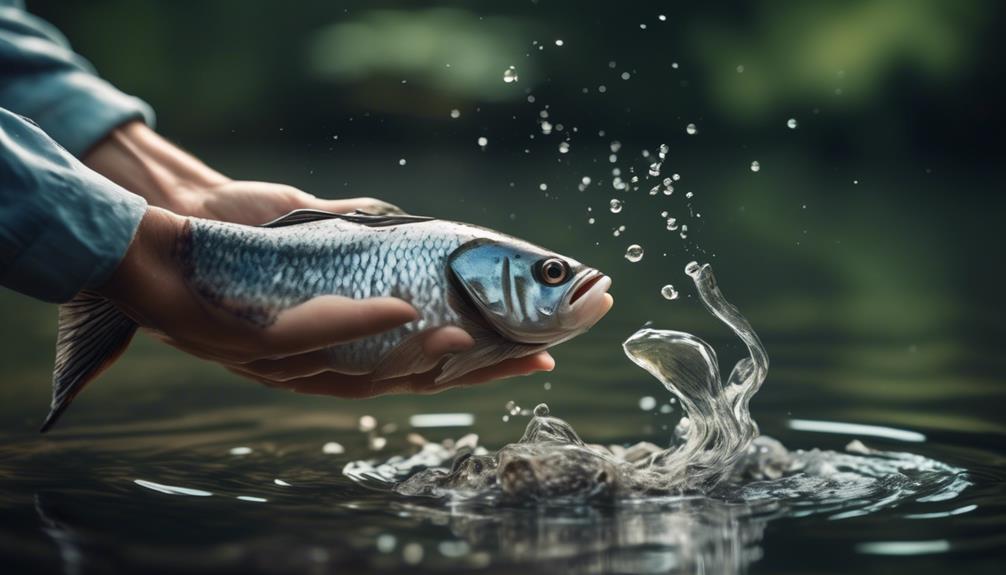When it comes to angling, you're like a steward of the water, entrusted with the well-being of its inhabitants.
Smart catch-and-release tactics are essential for preserving fish populations and ensuring the sustainability of your favorite pastime.
From selecting the right gear to understanding fish behavior, there's a plethora of techniques to master.
But where do you begin?
Let's explore some effective strategies that will not only enhance your angling experience but also contribute to the conservation of aquatic ecosystems.
Selecting the Right Gear
When selecting the right gear for catch-and-release angling, prioritize lightweight, durable equipment to enhance your maneuverability and reduce stress on the fish. Choosing eco-friendly gear is crucial for ethical fishing practices. Opt for fishing rods and reels made from sustainable materials such as bamboo, recycled aluminum, or other environmentally friendly materials. These options not only reduce the impact on the environment but also ensure that your gear is durable and reliable for numerous angling trips.
Look for lines and leaders that are biodegradable or made from recycled materials, as they minimize the risk of leaving behind harmful debris in the water and are less likely to harm marine life if accidentally discarded.
When it comes to hooks, select barbless options to minimize injury to the fish and make hook removal easier, reducing the handling time and stress on the fish. Additionally, using non-toxic weights and sinkers is essential for preserving the aquatic ecosystem and preventing harm to fish that might mistakenly ingest them.
Prioritizing gear that aligns with ethical fishing practices not only benefits the environment but also contributes to the well-being of fish populations, ensuring that they can be enjoyed by future generations of anglers.
Proper Hook and Line Selection
To ensure ethical angling practices, prioritize choosing barbless hooks and biodegradable lines, continuing the focus on eco-friendly gear selection from the previous subtopic.
When it comes to hook selection, consider the appropriate hook size for the fish species you're targeting. Using hooks that are too large can cause unnecessary harm to the fish, making it more difficult to release them safely. On the other hand, hooks that are too small may not be effective in securely hooking the fish, leading to prolonged fights and potential injury.
As for line selection, opt for a line strength that matches the targeted species. Using a line that's too light may result in extended fight times, exhausting the fish and reducing its chances of survival after release. Conversely, a line that's too heavy for the targeted species can cause unnecessary stress and potential injury during the fight. Additionally, consider using biodegradable lines to minimize the environmental impact in case of line breakage or loss.
When it comes to bait selection and lure presentation, choose artificial lures over live bait whenever possible, as they're less harmful to the fish. If using live bait, ensure that it's legal and ethically sourced. Properly presenting your bait or lure can also reduce the risk of deep hooking, making it easier to release the fish unharmed.
Minimizing Fight Time
Consider adjusting your fishing gear and techniques to minimize the amount of time it takes to reel in your catch. Minimizing fight time is crucial for the well-being of the fish you intend to release. By employing fish-friendly techniques and conservation-minded angling practices, you can reduce the stress and exhaustion experienced by the fish, increasing its chances of survival after release.
To minimize fight time, follow these tips:
- Use the Right Gear: Opt for a rod and reel combination that matches the size of the fish you're targeting. Lighter tackle allows you to tire out the fish more quickly, reducing fight time and stress on the fish.
- Set the Drag Properly: Adjust your drag to an appropriate setting. Properly set drag can prevent the fish from making long runs, which can exhaust the fish unnecessarily.
- Keep the Fish in the Water: Minimize fight time by keeping the fish in the water as much as possible. This allows the fish to breathe and reduces its stress levels.
- Avoid Overplaying the Fish: Once you've hooked a fish, aim to bring it in efficiently. Prolonging the fight by overplaying the fish can lead to exhaustion and decreased chances of survival post-release.
Handling and Releasing Fish Carefully
Handle fish carefully to minimize stress and injury during release. When handling a fish, it's crucial to remember that they can experience stress, just like any other living creature. By minimizing the time that a fish is out of the water and handling them gently, you can significantly reduce the stress they experience. This is important not only for the well-being of the fish but also for the overall health of the fish population and the environment. When fish are overly stressed, it can impact their ability to survive after being released, ultimately affecting the balance of the ecosystem.
Additionally, handling fish carefully and releasing them properly can have a positive environmental impact. Fish that are released with minimal stress and injury are more likely to survive and thrive after being caught. This contributes to the sustainability of fish populations and helps maintain the natural balance within aquatic ecosystems.
Understanding Fish Behavior
When practicing ethical angling and aiming to minimize stress and injury during release, understanding fish behavior becomes essential for effectively interacting with the aquatic environment. By comprehending how fish behave in their natural habitat, you can enhance your angling experience and ensure the well-being of the fish population.
Here are some key points to consider:
- Fish Feeding Patterns: Understanding when and where fish feed can significantly improve your angling success. Different species exhibit varied feeding behaviors, such as surface feeding, bottom feeding, or actively seeking prey in specific water conditions. By observing these patterns, you can adjust your angling techniques to mimic natural prey and attract fish more effectively.
- Spawning Behavior: Being aware of fish spawning seasons and locations is crucial for ethical angling. Disturbing spawning fish can be detrimental to their reproductive success and the overall health of the fish population. By respecting spawning areas and seasons, you contribute to the sustainability of fish stocks and help maintain a balanced ecosystem.
- Reaction to Environmental Factors: Fish behavior is influenced by environmental factors such as water temperature, oxygen levels, and weather conditions. Understanding how these factors impact fish movement and feeding activity can guide your angling strategies, allowing you to adapt your approach based on the prevailing conditions.
- Territorial Behavior: Many fish species exhibit territorial behavior, defending their preferred habitats from intruders. Recognizing these behaviors can help you avoid unnecessary stress to fish and reduce the risk of injury during catch-and-release practices.
Using Barbless Hooks
Using barbless hooks can reduce the potential harm to fish during hook removal and release, promoting ethical angling practices. When you use barbless hooks, they're easier to remove from the fish's mouth, causing less damage and stress. This reduces the handling time and the risk of injury to the fish, ultimately increasing its chances of survival after being released.
Additionally, barbless hooks make it easier to document your catch. Since they're easier to remove, you can quickly unhook the fish, minimizing the time it spends out of the water. This allows for efficient catch documentation through photography or measurements without causing unnecessary harm to the fish.
Furthermore, using barbless hooks aligns with the principles of catch-and-release fishing, as it prioritizes the well-being of the fish. By minimizing the potential damage caused by the hook during removal, you're actively contributing to the conservation of fish populations. This ethical approach to angling not only benefits the individual fish but also supports the sustainability of the entire ecosystem.
Reviving Exhausted Fish
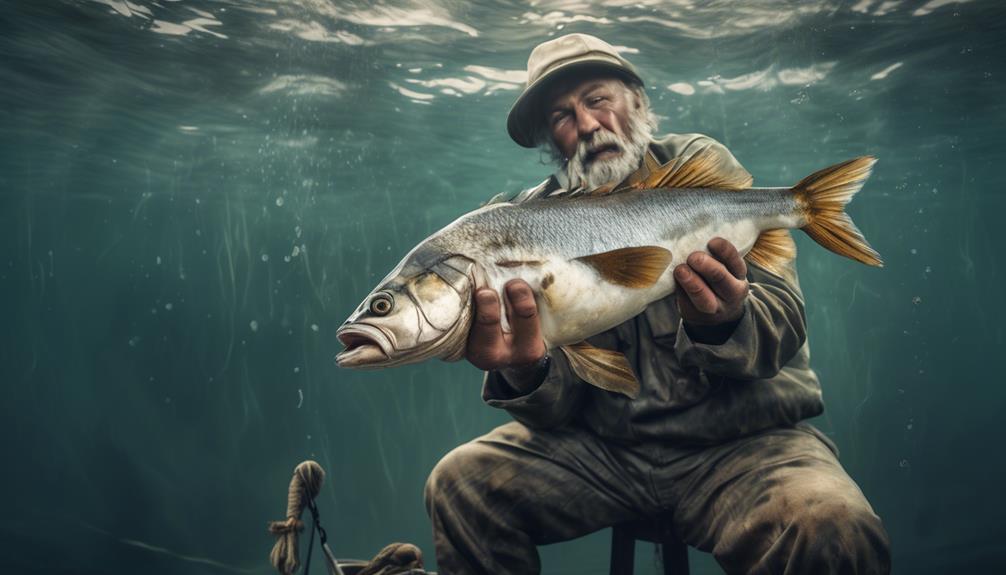
To ensure the well-being of the fish and contribute to their survival, it's essential to understand and implement effective techniques for reviving exhausted fish after catch-and-release. Reviving a tired fish is crucial to its survival, and there are several techniques you can use to ensure the fish swims away healthy and strong.
Here are some key techniques for reviving exhausted fish:
- Proper Handling: After catching a fish, handle it with care. Wet your hands before touching the fish to protect its slime layer, which is essential for its health. Avoid removing the fish from the water if possible, and if you need to, do so for the shortest time possible.
- Oxygenation Methods: If the fish appears exhausted, hold it in the water facing into a gentle current or move it back and forth to help water flow over its gills. This will help increase the oxygen flow and aid in the fish's recovery.
- Water Temperature: Before releasing the fish, ensure that it has fully recovered. If the water is warm, gently move the fish forward in the water to help it breathe and recover properly. In colder water, give the fish some time to gather its strength before it swims away.
- Reviving Techniques: If the fish doesn't swim away immediately, gently hold it upright underwater and move it back and forth to help water flow through its gills. This can help revive the fish and ensure its successful release.
Practicing Leave No Trace Principles
Practicing Leave No Trace Principles ensures minimal impact on the environment while engaging in angling activities. When it comes to ethical angling techniques, it's crucial to leave minimal impact on the natural surroundings. This involves being mindful of your actions and their potential consequences on the environment. As an angler, you can play a significant role in preserving the natural habitat by adhering to Leave No Trace Principles.
To leave minimal impact, start by properly disposing of any fishing line, hooks, or other gear. These items can be harmful to wildlife if left behind. Additionally, avoid damaging vegetation and disturbing wildlife while moving to and from fishing spots. Be mindful of where you step and try to leave the area exactly as you found it.
Furthermore, practicing catch-and-release fishing responsibly is another aspect of leaving minimal impact. Always handle fish with wet hands to protect their delicate skin and scales. Avoid removing them from the water for extended periods and release them gently to minimize stress. By using barbless hooks, you can reduce the potential harm to the fish during the release process.
Frequently Asked Questions
How Can Anglers Ensure That Their Catch-And-Release Efforts Are Not Negatively Impacting Fish Populations in the Long Term?
To ensure your catch-and-release efforts don't harm fish populations long term, focus on minimizing impact and long-term conservation.
Ethical handling and stress reduction are crucial. Use barbless hooks, handle fish with wet hands, and minimize air exposure. Avoid deep hooks and practice proper release techniques.
Support sustainable fishing regulations and spread awareness about ethical angling practices.
Your efforts can make a big difference in preserving fish populations for the future.
Are There Any Specific Techniques or Tools That Can Help Anglers Minimize Stress on Fish During the Release Process?
When handling fish for release, use proper tools and techniques to reduce stress, improving fish survival and lessening environmental impact. Consider using barbless hooks, wet hands, and avoiding contact with gills.
Minimize air exposure and support the fish in the water until it's ready to swim away. These fish handling practices help ensure their well-being post-release and contribute to sustainable angling.
What Are Some Common Mistakes Anglers Make When Practicing Catch-And-Release, and How Can They Avoid Them?
When practicing catch-and-release, anglers often make common mistakes that can harm fish. Proper handling is key to minimizing stress. Avoiding over-handling or mishandling fish is crucial.
Always wet your hands before touching fish to avoid damaging their protective slime layer. Use barbless hooks for easy removal and minimize handling time.
Lastly, increase conservation awareness by using the right gear and learning about fish behavior, ensuring their well-being after release.
How Can Anglers Effectively Communicate the Importance of Ethical Angling Practices to Others in Their Fishing Community?
To effectively communicate the importance of ethical angling practices to others in your fishing community, engage in peer education.
Share knowledge about catch-and-release benefits and its impact on fish populations. Lead by example, demonstrating social responsibility.
Organize community events or workshops to discuss ethical angling. Encourage open dialogue, and provide resources for proper catch-and-release techniques.
Are There Any Specific Regulations or Guidelines That Anglers Should Be Aware of When Practicing Catch-And-Release in Different Fishing Locations?
When fishing in different locations, it's important to be aware of specific regulations and guidelines for catch-and-release practices. Different areas may have varying rules regarding the handling and release of fish.
Always check local fishing regulations to ensure you're following the correct procedures. Some guidelines might include using barbless hooks, minimizing air exposure, and handling fish with wet hands.
Being informed about these regulations helps protect the fish population and ensures ethical angling practices.
Conclusion
So next time you head out for a day of angling, remember to use these smart catch-and-release tactics for ethical fishing.
By choosing the right gear, handling fish carefully, and understanding their behavior, you can enjoy the sport while also ensuring the safety and well-being of the fish population.
It's all about being a responsible angler and leaving no trace behind.
Happy fishing!
